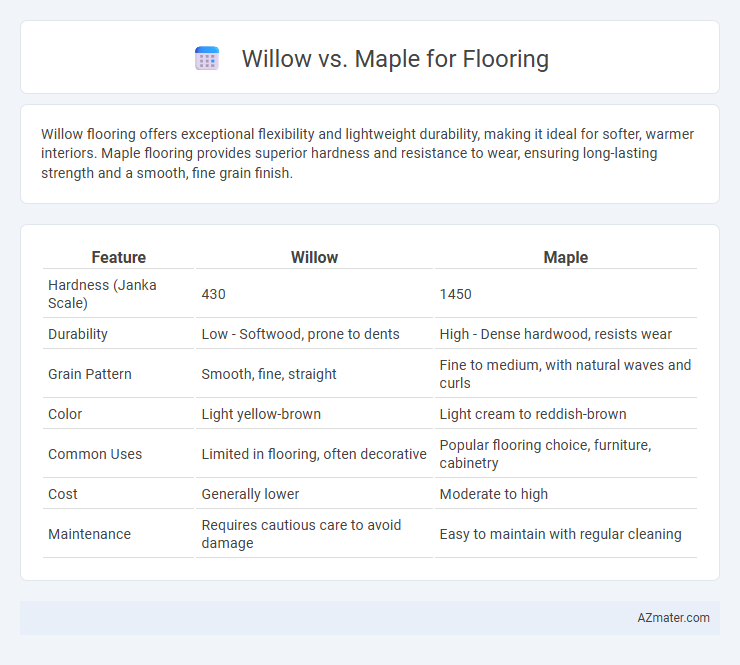Willow flooring offers exceptional flexibility and lightweight durability, making it ideal for softer, warmer interiors. Maple flooring provides superior hardness and resistance to wear, ensuring long-lasting strength and a smooth, fine grain finish.
Table of Comparison
| Feature | Willow | Maple |
|---|---|---|
| Hardness (Janka Scale) | 430 | 1450 |
| Durability | Low - Softwood, prone to dents | High - Dense hardwood, resists wear |
| Grain Pattern | Smooth, fine, straight | Fine to medium, with natural waves and curls |
| Color | Light yellow-brown | Light cream to reddish-brown |
| Common Uses | Limited in flooring, often decorative | Popular flooring choice, furniture, cabinetry |
| Cost | Generally lower | Moderate to high |
| Maintenance | Requires cautious care to avoid damage | Easy to maintain with regular cleaning |
Introduction to Willow and Maple Flooring
Willow flooring, derived from the flexible and lightweight willow tree, offers unique grain patterns and a softer texture ideal for warm, natural interior aesthetics. Maple flooring, sourced from the hard and dense sugar maple tree, is renowned for its durability, fine grain, and light, uniform color that complements both modern and traditional designs. Both materials provide distinct advantages, with willow emphasizing aesthetic warmth and maple excelling in strength and longevity for high-traffic areas.
Botanical Differences: Willow vs Maple
Willow flooring originates from the Salix genus, featuring flexible, lightweight wood with a distinctive open grain and natural resistance to moisture, making it suitable for humid environments. Maple, derived from the Acer genus, offers a dense, hard wood with a fine, uniform grain pattern that provides exceptional durability and resistance to wear. The botanical differences reflect in their structural properties: willow's softer, pliable nature contrasts with maple's hardness and strength, influencing flooring choices based on environmental conditions and usage requirements.
Appearance and Grain Patterns
Willow flooring presents a lighter, more uniform appearance with subtle, fine grain patterns, giving interiors a soft and modern look. Maple flooring offers a warm, creamy tone with distinctive, tight grain patterns that range from uniform to wavy, adding character and richness to any space. Both woods are visually appealing, but maple's pronounced grain makes it ideal for those seeking a classic, textured aesthetic, while willow suits minimalist, airy designs.
Durability and Hardness Comparison
Willow flooring exhibits moderate durability with a Janka hardness rating around 350, making it softer and more prone to dents compared to maple. Maple is significantly harder and more durable, boasting a Janka hardness of approximately 1450, ideal for high-traffic areas and heavy use. The higher density and hardness of maple contribute to its superior resistance to wear and impact, extending the lifespan of flooring installations.
Installation and Workability
Willow flooring offers exceptional workability due to its lightweight fibers, making it easier to cut and install compared to denser hardwoods like maple. Maple's hardness provides durability but requires more effort and specialized tools for precise installation, increasing labor time and costs. Both materials benefit from proper subfloor preparation, but willow's flexibility can reduce installation challenges in uneven areas.
Maintenance and Longevity
Willow flooring requires minimal maintenance due to its natural resistance to moisture and scratches, making it ideal for high-traffic areas. Maple flooring offers superior durability with a harder surface that withstands heavy wear, but it may need periodic refinishing to maintain its appearance. Both woods provide long-lasting options, with maple typically lasting longer due to its density and structural strength.
Cost and Affordability
Willow flooring generally offers a more affordable option compared to maple, with prices often ranging between $2 to $5 per square foot, making it suitable for budget-conscious projects. Maple, known for its durability and fine grain, typically costs between $4 to $8 per square foot, reflecting its higher-end appeal and longer lifespan. Choosing willow can reduce initial installation expenses without significantly compromising aesthetic value, while maple provides greater long-term value through enhanced toughness and wear resistance.
Environmental Impact and Sustainability
Willow flooring offers a renewable option due to its fast growth rate and ability to regenerate quickly after harvesting, minimizing deforestation risks. Maple, while durable and long-lasting, grows slower and requires more extended periods to mature, which can contribute to greater environmental strain if not sourced sustainably. Selecting FSC-certified maple or reclaimed wood enhances sustainability by ensuring responsible forest management and reducing ecological footprints.
Pros and Cons of Willow Flooring
Willow flooring offers a unique, rustic appearance with a warm golden hue and distinctive grain patterns, adding character to any interior space. Its softness provides comfort underfoot and reduces noise, making it ideal for living areas, but it is less durable and more prone to dents and scratches compared to harder hardwoods like maple. Willow requires regular maintenance and careful handling to preserve its beauty, whereas its lower hardness rating makes it less suitable for high-traffic or commercial spaces.
Pros and Cons of Maple Flooring
Maple flooring offers exceptional durability and resistance to wear, making it ideal for high-traffic areas and long-lasting use. Its fine, uniform grain provides a sleek, contemporary appearance but may lack the distinctive character found in more textured woods like willow. While maple is harder and less prone to dents than willow, it can be susceptible to moisture damage if not properly sealed, requiring careful maintenance to preserve its finish.

Infographic: Willow vs Maple for Flooring
 azmater.com
azmater.com